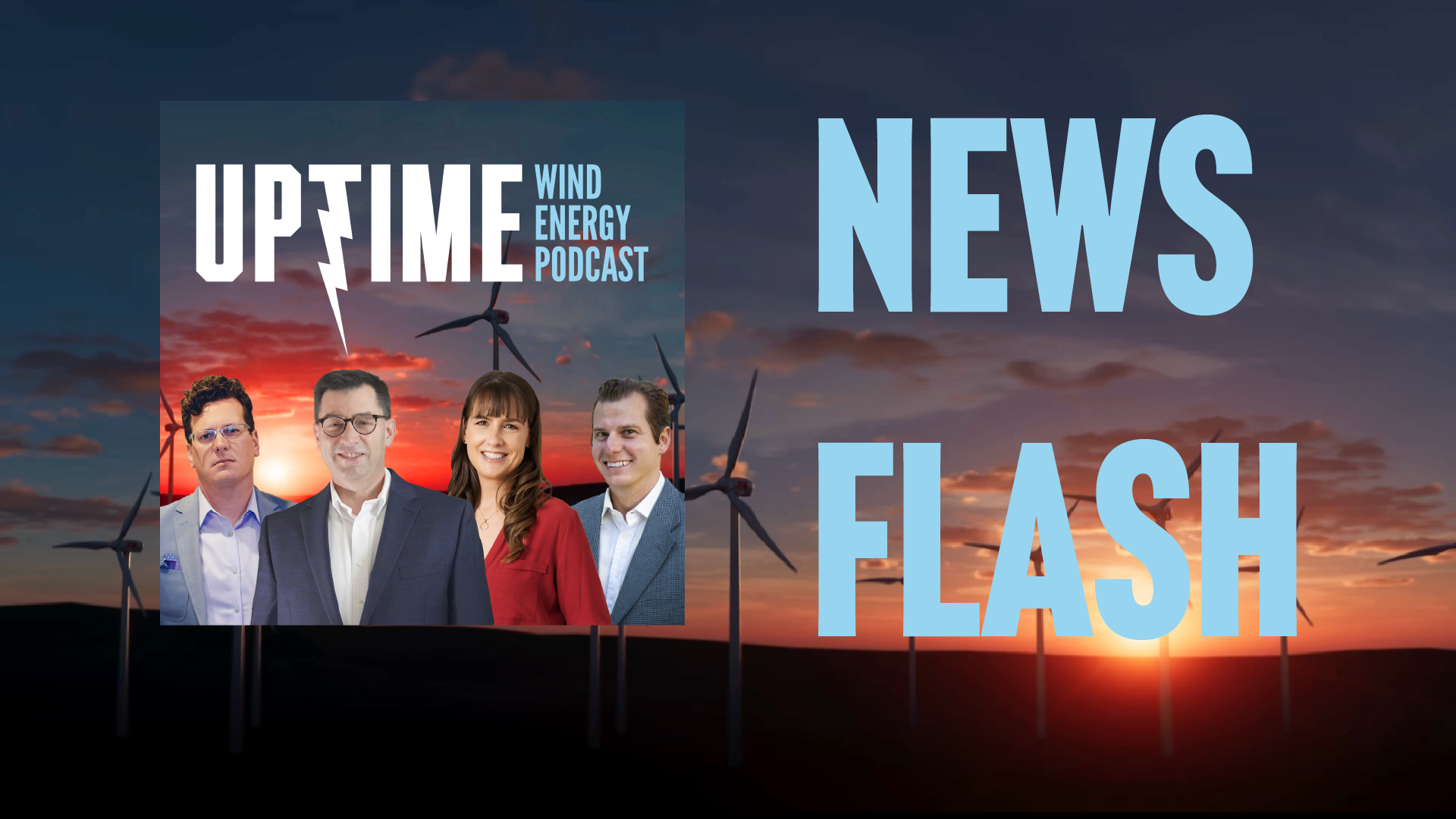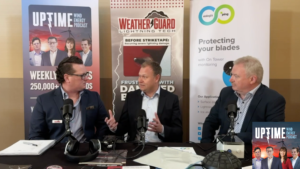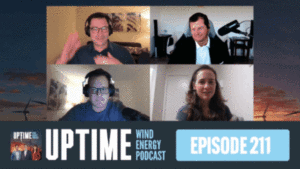Podcast: Play in new window | Download
Ørsted forms long-term charter with Cadeler for a new wind turbine installation vessel, Quinnbrook Infrastructure Partners successfully closes of its $600 million Quinnbrook Valley of Fire Fund, and Canada Pension Plan Investment Board consolidates its offshore wind holdings into its dedicated global offshore wind platform, Reventus Power.
Sign up now for Uptime Tech News, our weekly email update on all things wind technology. This episode is sponsored by Weather Guard Lightning Tech. Learn more about Weather Guard’s StrikeTape Wind Turbine LPS retrofit. Follow the show on Facebook, YouTube, Twitter, Linkedin and visit Weather Guard on the web. And subscribe to Rosemary Barnes’ YouTube channel here. Have a question we can answer on the show? Email us!
Pardalote Consulting – https://www.pardaloteconsulting.com
Weather Guard Lightning Tech – www.weatherguardwind.com
Intelstor – https://www.intelstor.com
Allen Hall: I’m Allen Hall, president of Weather Guard Lightning Tech, and I’m here with the founder and CEO of IntelStor, Phil Totaro, and the chief commercial officer of Weather Guard, Joel Saxum. And this is your News Flash. News Flash is brought to you by our friends at IntelStor. If you want market intelligence that generates revenue, then book a demonstration of IntelStor at IntelStor. com.
Offshore wind developer, Ørsted, has signed a long term charter with Cadeler for a new A class wind turbine installation in Vessel, the hybrid vessel can transport and install both turbine foundations and the turbines themselves and has a capacity for six double XL monopile foundations or seven complete 15 megawatt turbine setups per trip.
The partnership extends Ørsted and Cadeler’s collaboration as the offshore wind industry scales up to meet ambitious targets. Now, Phil offshore developers and ship developers make a lot of sense here just because of the lack of ships and the, all the pressure to try to lock in ship time.
Philip Totaro: Yeah, absolutely.
And given some of the past experience Ørsted’s had with lack of vessel availability, it was part of what they claimed was the rationale for pulling out of some of the projects in the U. S. as well. Was lack of vessel availability. So this gives them something dedicated and assumes that they’re obviously also going to have a big pipeline of projects to be able to go justify, spending, I’m conservatively thinking about 225 million on an installation vessel of that size.
So, this is it’s a great deal and it helps certainly provides certainty for Kettler as well who, Also, I just got through their merger last year with Anetti. So this, it’s I think this is a great thing that that both companies are going to be able to benefit from.
And it certainly brings Ørsted some certainty on a vessel capable of deploying, what is currently the latest generation of Western developed technology.
Joel Saxum: So Cadeler has four existing vessels and six next gen new builds on order, right? That makes them the world’s largest wind turbine installation vessel operator.
And what this does by Ørsted saying, we will put a charter on one of them from 27 to 2030. So that’s a four year long charter. You see this in the SOV market as well, but a lot of times the SOV market, they’re a little bit more extended because they’re going to say we own this wind farm. We’re going to be operating it for the next 10, 15 years.
Sometimes you see SOV contracts like that for 10, 15 years. I’ve seen them through a couple of years ago. I saw some through 2038. That we’re on contract, right? So that’s enough money or promise for a company like Cadeler to build something, right? SVACT has done a bunch of things in that sort. Ørsted coming, of course, off the tail end of a lot of the installation projects that they’ve done.
Struggling, scrambling to find these vessels, saying, you know what, no, we’re just going to sign an agreement. We want one, we’re going to have it for four years, and we’re going to utilize it for four years.
Allen Hall: Good move. Quinnbrook Infrastructure Partners has successfully closed its 600 million U. S. dollar Quinnbrook Valley of Fire Fund.
The fund is led by Blackstone Strategic Partners and Ares Management Infrastructure Secondaries Funds. The portfolio includes the Gemini project, one of the largest operational solar and storage projects in the U. S. and the Valley of Fire portfolio, consisting of seven projects with a total PV capacity of over 2.
65 gigawatts and a potential for 1. 5 gigawatt of battery storage across Nevada, Colorado, And Arizona. So Phil, as we have seen large wind deployments across multiple states at this point. We’re seeing the same sort of thing happen in solar and battery storage to balance the grid, right?
Philip Totaro: Yeah, and this comes at a time when you know, FERC and some of the national labs in the U. S. have just released an updated report about the interconnection queues, where wind, solar, and especially solar and storage are taking up But the majority, the overwhelming majority of these queues, so there’s a huge amount of need for capital deployment on solar and storage, but also hybrid projects where you’ve got wind, solar and storage, potentially all being built together and in a single project site in a single interconnection, which is going to help.
Kind of expedite more grid stability and power offtake. All in all, I think this ends up being a good thing for Quinnbrook.
Joel Saxum: I’m talking Ares management infrastructure here. These are the part of the group that’s leading this fund. They bought Apex Clean Energy.
So you can see more and more of the same style of things like we’ve been talking about with Blackrock with Larry Fink talking about deploying capital into these infrastructure projects. You’re seeing a lot of these bigger funds scooping up investment, scooping up development, scooping up active assets in the renewable energy space.
I think Ares is actually has 11 billion invested in a four and a half or 45 gigawatts of generation and transmission capacity. So the big money is moving into these spaces.
Allen Hall: Canada Pension Plan Investment Board is consolidating its existing direct and indirect offshore wind holdings into its UK based portfolio company, Reventus Power.
Now, Reventus Power will become CPP’s investments dedicated global offshore wind platform, with teams in the UK, Germany, Poland, and Portugal forming a group of approximately 50 offshore wind specialists. www. reventus. com CPP investments current exposure to offshore wind exceeds about 1 billion Canadian dollars.
So Phil, we’re seeing this a lot with investment groups where they’re starting to staff up and create an organization to support the investments they’re in. What makes this Canada Pension Plan unique?
Philip Totaro: Keep in mind as well that they’ve actually got a significant amount of asset ownership also in onshore wind in Brazil and this new venture is also looking at offshore wind projects in places like Australia where they’ve got an application in a consortium.
mainstream renewables AGL and direct infrastructure. Yeah, this is I think a great thing that they’re doing where, CPP investments can really start leveraging a lot of the, they’re, I think the number one or number two pension in all of Canada.
The other one, I think, being the Ontario teachers pension. This is a big deal and they’ve got a lot of capital to deploy and they like renewables and I think they’re going to keep scaling in this way.
Joel Saxum: I think the interesting thing here that I want to touch on is something that is a trend that Allen and I have been talking about quite regularly, but the sentence here in the press release of forming a group of approximately 50 offshore wind specialists.
What we’re seeing in the industry is there used to be, or there still is, a lot of financial asset owners. That are, we’re the financial we provide the capital, we buy the projects, you develop the projects, you run them, blah, blah, blah. But what we’re seeing is these investment groups to protect their investments are actually bringing on specialists and engineers to watch over their assets in a, a more active manner than they have in the past.
Simply because. Performance of the assets when you’re just hands off, hasn’t been as prime as they want them to be. So more and more of these financial asset owners are employing engineers and staffing up.










